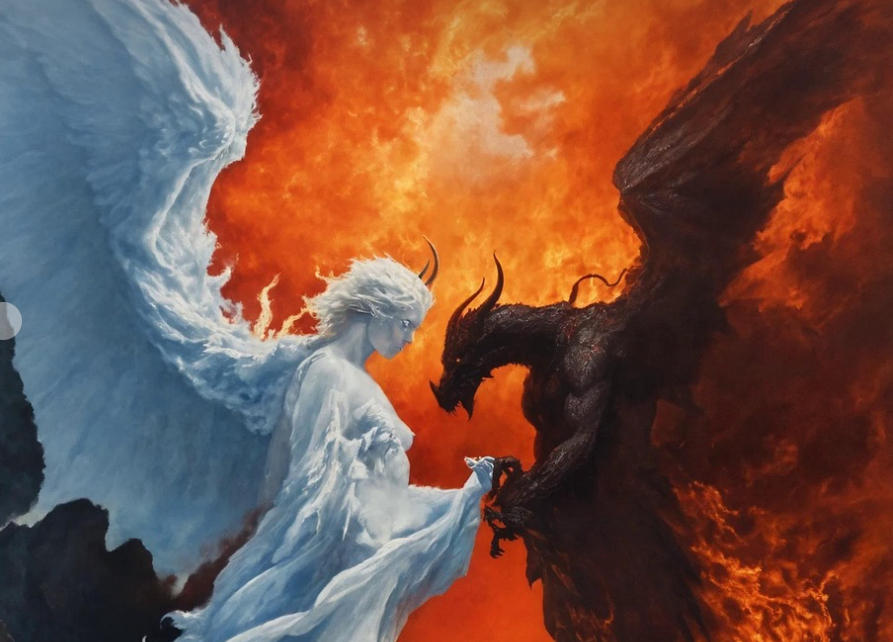An Article by DM (800 words, 4 min. read)
In the age of self-inflicted drama, one cannot help but wonder when exactly did beauty become a crime in Lebanese art. Galleries are nowadays filled with monstrous bodies, twisted faces, and canvases that appear to have been wounded rather than painted. There’s a certain pride in distortion thision, as if the more chaotic, burned, and miserable a painting looks, the more “profound” it must be. Artists compete in misery, estute curators applaud trauma, and collectors hang despair above their sofas with a glass of champagne in hand. Tragedy is now the new “décor”.
The Endless Repetition of Pain
War. Always the war. Its ghosts haunt every brushstroke, every sculpture, every installation that insists on reminding us of what we have not forgotten. The subject has fossilized into cliches. The wounds are now ornamental. We no longer feel; we perform feeling. Paintings scream, but the screams are rehearsed, stylized, profitable. What began as catharsis has turned into masochism; a national exhibition of self-pity disguised as depth. And all in the name of “it sells”, yet, the question remains, why does it sell to begin with?

When Art Forgets to Heal
The purpose of art is not to reopen the wound but to heal it, or at least to offer a moment of elevation above it. Yet, here we are, staring at endless canvases soaked in suffering, as though agony were the only legitimate form of sincerity. Artists seem to fear beauty, as if a harmonious line or a graceful composition might betray the seriousness of their pain. Beauty becomes suspicious, almost immoral. And so, the palette darkens, the shapes decay, and we applaud what we can no longer look at for more than a few seconds.
As one art therapist once wrote, “Art therapy is not about bleeding on the canvas, it’s about finding the strength to stop the bleeding.” Healing through art does not mean immortalizing the trauma, framing it, and selling it under perfect lighting. It means transforming pain into understanding, not into a product of despair. Somewhere along the way, the process was mistaken for the result.
As silhouettes hover over rubber wheels, and distorted, disproportioned figures cover large canvases, one cannot but find themselves looking for answers that soothe the soul without any success. One decides to run away and find refuge in another gallery, and what a mistake that was. A whirlwind of thought strikes the observer as they try to find answers in depictions of no mans land rather than a serene place one would wish to find themselves at. In other visits around town, one finds their inquisitive mind searching for heads that do not exist, or observing distorted giraffes that somehow made themselves a symbol of non-existent beauty. What has our world come to?

Hanging Ugliness at Home
One must ask, sincerely and without malice: what is the pleasure in hanging ugliness on our walls? Is it to prove our sophistication, our courage to face horror before breakfast? Or is it that pain is now the new luxury, a sign of intellectual depth, sold in limited editions? The contemporary living room has turned into a small museum of melancholy, where color has gone to die and irony has been replaced by tenderness.

The Fear of Beauty
There was a time when Lebanese art celebrated life even in ruins. Pain coexisted with grace; sorrow was expressed with light, not sludge. Today, beauty is treated as naïve, decorative, unserious. The irony, of course, is that ugliness is the new convention, the new conformity. Everyone rebels in the same direction. The real act of rebellion now would be to paint something luminous, to dare to be beautiful again.

A Final Plea: Let There Be Light
For those who promote ugly art that provokes and disturbs and makes one stop, reflect, with stirred emotions, one can argue that it does not take “art” to do that. Any visual distortion can do that, from the corpse of an animal on the side of the road to the ugliness of haphazard buildings with chaotic paint and intertangled electric lines. Ugliness is everywhere if one looks closely, we don’t need art to add to it. While artists with their techniques are sometimes amazingly interesting, and commendable at times, the whole picture is not just about technique, it is about everything else that brings about the work as a whole.
Art should not be a mirror of decay but a lamp in the dark. We have enough ruins outside; Must we replicate them endlessly on our walls? True depth lies not in illustrating pain but in transcending it. The artist’s duty is not to make us suffer more beautifully, it is to remind us that beauty still exists, stubbornly, even in a broken land.

